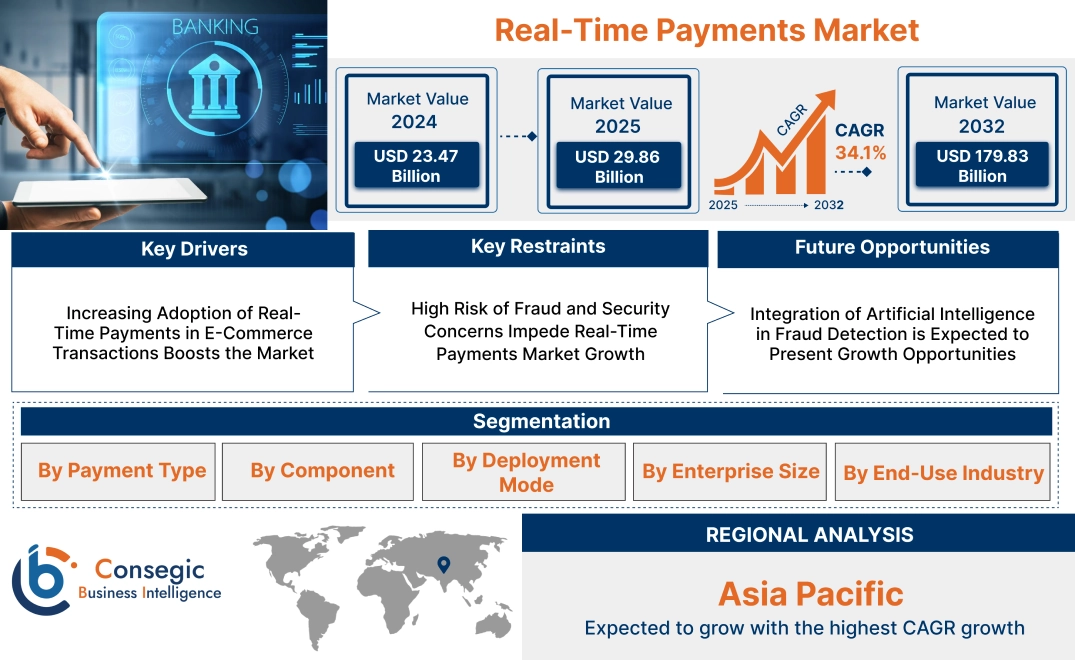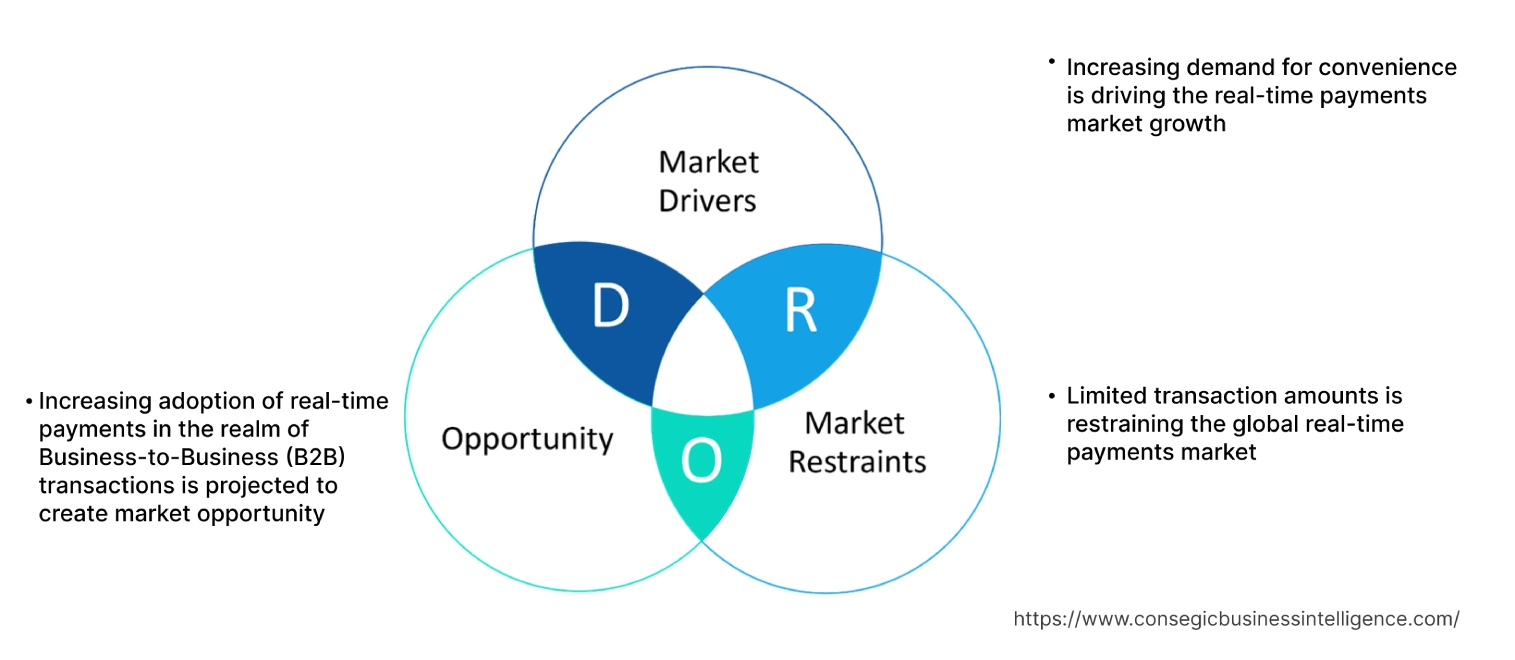- Summary
- Table Of Content
- Methodology
Real-Time Payments Market Size:
Real-Time Payments Market size is estimated to reach over USD 179.83 Billion by 2032 from a value of USD 23.47 Billion in 2024 and is projected to grow by USD 29.86 Billion in 2025, growing at a CAGR of 34.1% from 2025 to 2032.
Real-Time Payments Market Scope & Overview:
Real-time payments facilitate instant money transfers between banks and financial institutions, enabling secure and immediate transaction processing. These systems operate 24/7, ensuring continuous availability for users. They support various payment methods, including peer-to-peer transactions, business payments, and government disbursements.
Key features include instant fund settlement, fraud detection, and integration with digital wallets and banking platforms. These systems enhance transaction transparency, minimize delays, and improve cash flow management. It also incorporates advanced security measures, including encryption and authentication protocols, to protect user data.
The benefits include enhanced financial efficiency, reduced transaction costs, and improved customer convenience. These payments support multiple industries, including banking, retail, healthcare, and e-commerce. Businesses use them for payroll processing, vendor payments, and subscription-based transactions. It also streamlines cross-border transfers, enabling seamless financial transactions across global markets.
Key Drivers:
Increasing Adoption of Real-Time Payments in E-Commerce Transactions Boosts the Market
The rapid adoption of e-commerce has necessitated faster and more secure payment solutions to enhance customer experience and ensure seamless transactions. Real-time payment systems facilitate instant fund transfers between buyers and merchants, eliminating delays associated with traditional banking methods. These payment systems provide real-time confirmation, reducing cart abandonment rates and improving customer trust in online platforms. For instance, major e-commerce platforms integrate real-time payment solutions to offer customers instant payment settlement, ensuring a smooth checkout process. Therefore, the increasing integration of instant payments in e-commerce transactions significantly boosts real-time payments market expansion.
Key Restraints:
High Risk of Fraud and Security Concerns Impede Real-Time Payments Market Growth
Real-time payments, while offering speed and convenience, also pose significant security challenges due to the immediate and irreversible nature of transactions. Fraudsters exploit these systems to conduct unauthorized transactions, leading to financial losses for businesses and consumers. Cybercriminals use techniques such as account takeovers, identity theft, and phishing attacks to gain access to real-time payment networks. Due to the instant processing of transactions, reversing fraudulent payments becomes challenging, making security a major concern. These increasing fraud risks and security challenges hinder the widespread adoption of real-time payment systems, particularly among businesses that require robust fraud prevention measures.
Future Opportunities :
Integration of Artificial Intelligence in Fraud Detection is Expected to Present Growth Opportunities
Artificial intelligence is anticipated to play a crucial role in enhancing the security of instant payments by identifying and preventing fraudulent transactions. AI-driven fraud detection systems analyze transaction patterns in real time to identify anomalies and suspicious activities, enabling proactive threat mitigation. For example, AI-based risk assessment models will allow financial institutions to implement advanced fraud prevention mechanisms, reducing unauthorized transactions and enhancing security. As the adoption of AI-driven fraud detection grows, the trust and reliability of immediate payments will improve, fostering greater market acceptance and expansion.
Real-Time Payments Market Segmental Analysis :
By Payment Type:
Based on payment type, the market is segmented into Person-to-Person (P2P), Person-to-Business (P2B), Business-to-Person (B2P), Business-to-Business (B2B), and others (e.g., Business-to-Government (B2G), Government-to-Business (G2B), Person-to-Government (P2G), Government-to-Person (G2P)).
The Business-to-Business (B2B) segment accounted for the largest revenue in real-time payments market share of 30.75% in 2024.
- Businesses are increasingly leveraging instant payments to streamline transactions, reduce processing delays, and improve cash flow management.
- The integration of immediate money transfers with enterprise resource planning (ERP) systems enhances operational efficiency and facilitates instant settlements.
- Increased adoption of automated and digital payment solutions by enterprises further contributes to real-time payments market expansion.
- The high transaction volume and the necessity for faster, more secure payment processing support the dominance of the B2B segment.
- Therefore, according to real-time payments market analysis, these aforementioned factors drive the revenue share of the B2B segment in the market.
The Person-to-Business (P2B) segment is anticipated to register the fastest CAGR during the forecast period.
- The increasing use of instant payments for e-commerce, bill payments, and retail transactions boosts the real-time payments market trend in this segment.
- The growing adoption of digital wallets, QR code payments, and contactless transactions enhances the penetration of instant payments in P2B transactions.
- Enhanced customer experience and convenience, coupled with rising smartphone penetration, further accelerate real-time payments market trend.
- Thus, according to real-time payments market analysis, the above-mentioned factors contribute to the rapid growth of the P2B segment in the market.
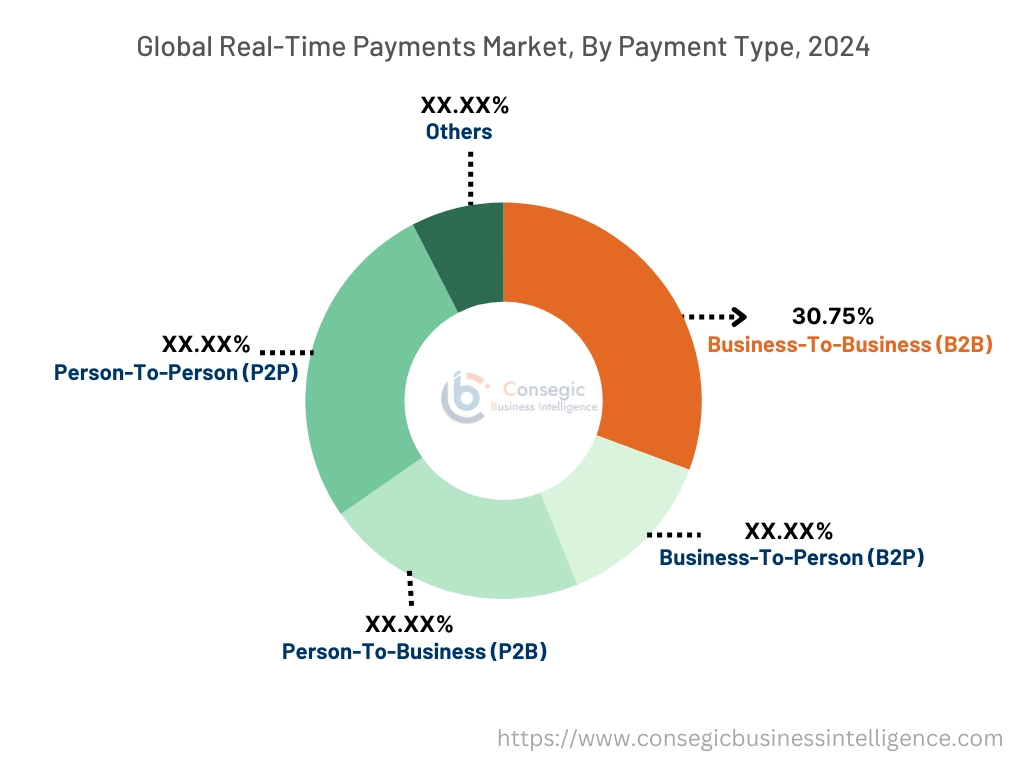
By Component:
Based on component, the market is segmented into solutions (payment gateway solutions, payment processing solutions, and payment security and fraud management solutions) and services (professional services and managed services).
The payment processing solutions segment accounted for the largest revenue in real-time payments market share in 2024.
- Businesses and financial institutions utilize payment processing solutions to facilitate secure and instant transactions.
- The increased deployment of Application Programming Interfaces (APIs) and cloud-based payment processing systems enhances efficiency and scalability.
- Rising transaction volumes in retail, BFSI, and e-commerce sectors contribute to the market share of this segment.
- Therefore, according to the market analysis, these aforementioned trends support the dominance of the payment processing solutions segment in the market.
The payment security and fraud management solutions segment is anticipated to register the fastest CAGR during the forecast period.
- The increasing instances of cyber threats and fraud risks drive the real-time payments market demand for advanced security solutions in real-time payment transactions.
- Implementation of artificial intelligence (AI)-driven fraud detection, biometric authentication, and blockchain-based security measures enhances real-time payment security.
- Regulatory compliance requirements and consumer demand for secure transactions accelerate the adoption of fraud management solutions.
- Thus, according to the market analysis, these aforementioned trends support the rapid growth of the payment security and fraud management solutions segment.
By Deployment Mode:
Based on deployment mode, the market is segmented into on-premises and cloud.
The cloud segment accounted for the largest revenue share in 2024 and is anticipated to register the fastest CAGR during the forecast period.
- Cloud-based real-time payment solutions offer scalability, cost-efficiency, and seamless integration with digital payment ecosystems.
- The adoption of Software-as-a-Service (SaaS) models and API-based platforms accelerates cloud deployment.
- Enhanced security protocols, real-time data analytics, and flexibility in managing transactions support the trend of cloud-based solutions.
- Thus, according to the market analysis, these aforementioned factors contribute to both the high revenue share and projected growth of the cloud segment in the market.
By Enterprise Size:
Based on enterprise size, the market is segmented into small and medium-sized enterprises (SMEs) and large enterprises.
The large enterprises segment accounted for the largest revenue share in 2024.
- Large enterprises utilize instant payments to enhance transaction speed, optimize working capital, and improve liquidity management.
- Integration of immediate payments with enterprise financial systems improves efficiency and reduces reconciliation efforts.
- The increasing adoption of real-time cross-border payment solutions by multinational corporations supports the adoption of this segment.
- Therefore, according to the market analysis, these aforementioned factors drive the dominance of the large enterprises segment in the market.
The small and medium-sized enterprises (SMEs) segment is anticipated to register the fastest CAGR during the forecast period.
- SMEs are rapidly adopting instant transfers to enhance cash flow management and improve operational efficiency.
- The proliferation of digital banking solutions and mobile payment applications facilitates the adoption of real-time payment systems among SMEs.
- The increasing availability of cost-effective cloud-based real-time payment solutions further accelerates market penetration.
- Thus, according to the market analysis, these aforementioned trends contribute to the high growth rate of the SMEs segment in the market.
By End-Use Industry:
Based on end-use industry, the market is segmented into banking, financial services, and insurance (BFSI), retail and e-commerce, IT and telecommunications, government, energy and utilities, and others (e.g., healthcare, media and entertainment, manufacturing, transport, travel and hospitality, education).
The BFSI segment accounted for the largest revenue share in 2024.
- The BFSI sector utilizes instant fund transfers for instant fund transfers, account settlements, and fraud prevention.
- Financial institutions and fintech firms implement real-time payment infrastructure to improve customer experiences and transaction transparency.
- The increasing adoption of open banking APIs and instant clearing systems supports the BFSI sector’s market share.
- Therefore, according to the market analysis, these aforementioned trends contribute to the significant revenue share of the BFSI segment in the market.
The retail and e-commerce segment is anticipated to register the fastest CAGR during the forecast period.
- The surge in online shopping, mobile commerce, and digital wallets drives real-time payment adoption in the retail sector.
- Businesses leverage real-time payments to offer seamless checkout experiences and instant refunds, enhancing customer satisfaction.
- The rising real-time payments market demand for frictionless, contactless, and QR-based payment methods further supports real-time payments market opportunities.
- Thus, according to the market analysis, these aforementioned trends contribute to the rapid growth of the retail and e-commerce segment in the market.
Regional Analysis:
The regions covered are North America, Europe, Asia Pacific, the Middle East and Africa, and Latin America.
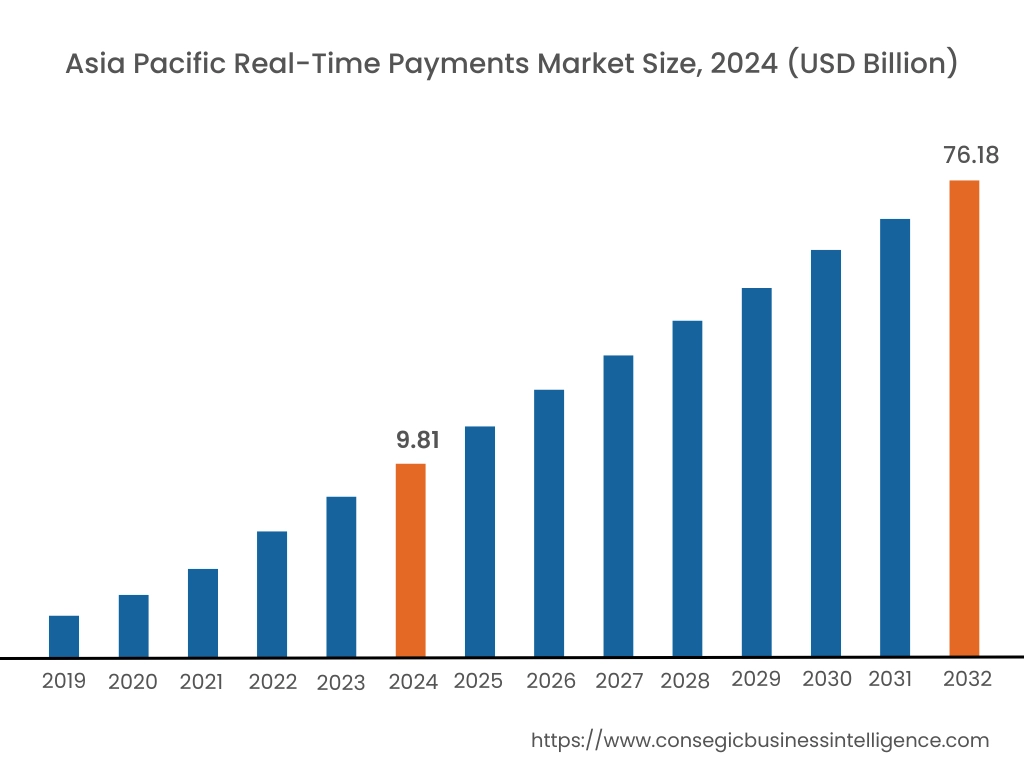
In 2024, Asia Pacific was valued at USD 9.81 Billion and is expected to reach USD 76.18 Billion in 2032. In Asia Pacific, China accounted for the highest share of 29.36% during the base year of 2024. Asia-Pacific is experiencing rapid adoption of real-time payments due to high smartphone penetration and government-led digital payment initiatives. Countries like China, India, Japan, and Australia are leading the market with advanced payment networks. Unified Payments Interface (UPI) in India and Faster Payments System (FPS) in Hong Kong enhance transaction efficiency. The region’s expanding e-commerce sector and fintech investments contribute to market development.
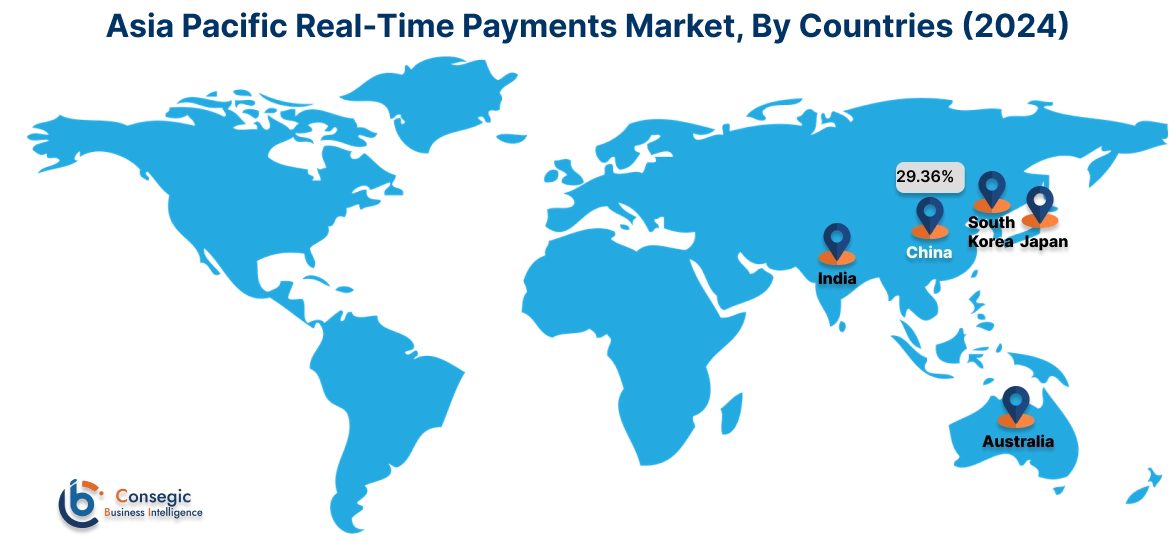
North America region was valued at USD 5.60 Billion in 2024. Moreover, it is projected to grow by USD 7.12 Billion in 2025 and reach over USD 42.75 Billion by 2032. North America holds a significant share of the market due to the strong presence of digital banking infrastructure. The United States and Canada are key contributors, with financial institutions investing in instant payment solutions. Regulatory initiatives, such as the Federal Reserve’s FedNow service, support real-time payments market opportunities. The rising demand for seamless digital transactions in e-commerce and retail further strengthens adoption.
Europe remains a key region in the market due to regulatory frameworks promoting instant transactions. The Single Euro Payments Area (SEPA) facilitates seamless cross-border transactions within the European Union. Countries like the United Kingdom, Germany, and France have well-established real-time payment systems. The increasing adoption of digital wallets and mobile banking solutions further supports market adoption.
The Middle East and Africa are witnessing increasing demand for real-time payments due to government initiatives promoting financial inclusion. Countries like the UAE, Saudi Arabia, and South Africa are implementing instant payment platforms. The expansion of digital banking services and fintech investments strengthens the market. Rising smartphone usage and cashless payment adoption drive transaction efficiency in the region.
Latin America is emerging as a growing market for real-time payments, with countries like Brazil, Mexico, and Argentina implementing instant payment networks. Brazil’s PIX system has accelerated digital transactions across multiple sectors. The increasing adoption of mobile banking and digital wallets supports market adoption. Government efforts to modernize financial systems and reduce cash dependency contribute to the adoption of real-time payment solutions.
Top Key Players and Market Share Insights:
The global real-time payments market is highly competitive with major players providing products and services to the national and international markets. Key players are adopting several strategies in research and development (r&d), product innovation, and end-user launches to hold a strong position in the global real-time payments market. Key players in the real-time payments industry include-
- Visa Inc. (United States)
- Mastercard Incorporated (United States)
- PayPal Holdings, Inc. (United States)
- Fiserv, Inc. (United States)
- FIS (Fidelity National Information Services, Inc.) (United States)
- ACI Worldwide, Inc. (United States)
- Temenos AG (Switzerland)
- Wirecard AG (Germany)
- Ripple Labs Inc. (United States)
- Ant Group (Alipay) (China)
Recent Industry Developments :
Product Launches:
- In January 2025, Visa partnered with social media platform X (formerly Twitter) to introduce "X Money" accounts. This collaboration enables users to transfer funds from debit cards and bank accounts to their X Money accounts, facilitating peer-to-peer payments on the platform.
- In August 2024, Switzerland initiated its instant electronic payments system, aligning with other European financial centers. Approximately 60 financial institutions, covering over 95% of retail payments, can now process instant payments, with plans for nationwide adoption by the end of 2026.
- In October 2024, Seven French banking groups introduced "Wero," a European electronic wallet developed by the European Payments Initiative (EPI) consortium. Initially facilitating peer-to-peer payments, Wero plans to expand its services to professionals and e-commerce by 2026, aiming to provide a competitive alternative to global payment giants.
- In October 2024, Bank of America launched "Virtual Payables Direct" in Spain and other European countries. This service targets large corporations, enabling efficient management of substantial payments, including last-minute and high-value transactions, without requiring technical modifications from suppliers.
Collaborations and Partnerships:
- In February 2025, BNP Paribas and BPCE finalized an agreement to create Estreem, a joint venture positioned to become one of Europe's top three payment processing entities. Estreem will handle 17 billion card payment transactions annually for both banks across Europe, securing a 30% share of France's card payment volume.
- In September 2024, the National Payments Corporation of India (NPCI) announced collaborations with countries in Africa and South America to develop digital payment systems modeled after India's Unified Payments Interface (UPI). Agreements were signed with the central banks of Peru and Namibia, with launches expected in two countries by early 2027.
Real-Time Payments Market Report Insights :
| Report Attributes | Report Details |
| Study Timeline | 2019-2032 |
| Market Size in 2032 | USD 179.83 USD Billion |
| CAGR (2025-2032) | 34.1 % |
| By Payment Type |
|
| By Component |
|
| By Deployment Mode |
|
| By Enterprise Size |
|
| By End-Use Industry |
|
| By Region |
|
| Key Players |
|
| North America | U.S. Canada Mexico |
| Europe | U.K. Germany France Spain Italy Russia Benelux Rest of Europe |
| APAC | China South Korea Japan India Australia ASEAN Rest of Asia-Pacific |
| Middle East and Africa | GCC Turkey South Africa Rest of MEA |
| LATAM | Brazil Argentina Chile Rest of LATAM |
| Report Coverage |
|
Key Questions Answered in the Report
How big is the Real-Time Payments Market? +
In 2024, the market was USD 23.47 Billion.
What will be the potential market valuation for the Real-Time Payments Market by 2032? +
In 2032, the market size of market is expected to reach USD 179.83 Billion.
What are the segments covered in the market report? +
The payment type, component, deployment type, enterprise size, and end-user industry are the segments covered in this report.
Who are the major players in the Real-Time Payments Market? +
Visa Inc. (United States), Mastercard Incorporated (United States), PayPal Holdings, Inc. (United States), Fiserv, Inc. (United States), FIS (Fidelity National Information Services, Inc.) (United States), ACI Worldwide, Inc. (United States), Temenos AG (Switzerland), Wirecard AG (Germany), Ripple Labs Inc. (United States), Ant Group (Alipay) (China) are the major players in the market.
